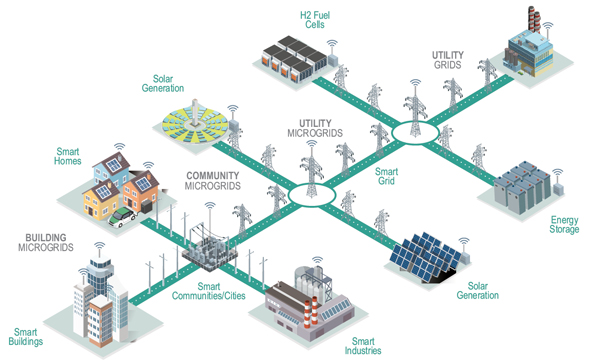Microgrids
Microgrids are localized energy systems that generate, distribute, and store electricity in a confined geographical area, offering increased resilience, efficiency, and integration of renewable resources.

A microgrid comprises three basic components: an energy generator, a storage unit, and a controller to manage energy flow and usage. (Image: Energy Producing Retail Realty)
View open jobs in this Solution
Example Companies
- Nuru - Nuru is a renewable and environment company that specializes in the fields of storage micro-grids and solar energy.
- Schneider Electric - Provides microgrid solutions for various applications.
- Siemens - Offers microgrid control systems and integration services.
- ABB - Develops microgrid solutions for remote communities and industrial applications.
- Tesla - Produces energy storage solutions for microgrids.
- Bloom Energy - Provides fuel cell technology for microgrid applications.
Overview
Microgrids are localized energy systems that generate, distribute, and store electricity in a confined geographical area. They can operate autonomously or in conjunction with the main grid, enabling communities, campuses, or facilities to produce and manage their energy independently.
Progress Made
Significant advancements have been made in microgrid technologies:
- Energy Storage: Improvements in battery technology, such as Tesla's Powerwall, enhance the dispatchability of renewable energy sources.
- Smart Controls: Advanced control systems enable efficient management of multiple energy sources within microgrids.
- Renewable Integration: Increased ability to integrate various renewable energy sources into microgrid systems.
Solutions by Sector
Remote Communities
- Island Microgrids: Providing reliable power to remote island communities.
- Rural Electrification: Using microgrids to bring electricity to off-grid rural areas.
- Indigenous Communities: Empowering indigenous communities with sustainable energy solutions.
Case Studies:
- Ta'u Island, American Samoa: Solar and battery microgrid powering the entire island (Tesla).
- Borrego Springs, California: Community microgrid improving reliability in a remote desert town (San Diego Gas & Electric).
- Kodiak Island, Alaska: Renewable microgrid stabilizing power for an isolated Alaskan community (ABB).
Military and Critical Infrastructure
- Military Bases: Enhancing energy security and resilience for military installations.
- Hospitals: Ensuring uninterrupted power supply for critical healthcare facilities.
- Data Centers: Providing reliable and efficient power for data center operations.
Case Studies:
- Fort Carson, Colorado: Military base microgrid demonstrating cybersecurity and resilience (Schneider Electric).
- Parkland Hospital, Texas: Hospital microgrid ensuring continuous operation during grid outages (Enchanted Rock).
- Montgomery County, Maryland: Public safety microgrid powering critical county facilities (Schneider Electric).
Commercial and Industrial��
- Campus Microgrids: Providing energy independence for university and corporate campuses.
- Industrial Parks: Enhancing power quality and reliability for manufacturing facilities.
- Smart Cities: Integrating microgrids into urban energy systems for improved efficiency and resilience.
Case Studies:
- University of California, San Diego: Campus-wide microgrid integrating multiple energy sources (Siemens).
- Lidl Finland: Microgrid solution for a distribution center, integrating solar and energy storage (Siemens).
- Port of San Diego: Microgrid project enhancing energy resilience and reducing emissions (Pasha Stevedoring & Terminals).
Lessons Learned
- Reliability: Microgrids offer increased energy reliability during main grid outages.
- Emissions Reduction: Integration of renewable energy sources can significantly reduce carbon emissions.
- Customization: Microgrids can be tailored to specific local needs and available resources.
- Planning and Coordination: Successful microgrid implementation requires meticulous planning and stakeholder coordination.
Challenges Ahead
- Standardization: Lack of standardization among microgrid types hinders comparison and choice.
- High Upfront Costs: Initial investment costs can be a barrier to widespread adoption.
- Regulatory Barriers: Existing regulations may not adequately support microgrid development and operation.
- Technical Complexity: Managing multiple energy sources and grid interactions can be technically challenging.
Best Path Forward
- Technology Improvement: Continue research and development to improve efficiency and reduce costs.
- Public Education: Increase awareness about the benefits and potential of microgrids.
- Policy Support: Develop supportive policies and regulations to encourage microgrid adoption.
- Financing Options: Expand financing mechanisms to make microgrids more accessible.
- Standardization: Work towards industry standards for microgrid components and operations.
Image credit: Energy Producing Retail Realty